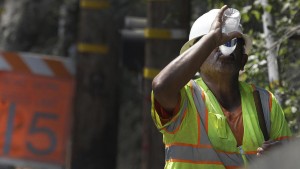Essay by S. Tom Bond, Resident Farmer, Jane Lew, WV
We have heard about Houston and the Harvey Hurricane, in fact it has occupied the news almost to the exclusion of everything else some days. But it isn’t alone. Harvey made landfall the 25th of August, and was a source of great devastation by high wind and rainfall in Texas and Louisiana until the first of September. Some areas had 50 inches of rain. Only one-tenth of the damage was covered by insurance, and the U. S. may only be able to come up with one-half the money needed for federal flood relief. It will be the first or second most expensive natural disaster in U. S. history.
In India, from Mumbai to Bangladesh and north to the Himalayas, exceedingly heavy Monsoon rains caused a flood that caused 1,200 people to die and 40 million have been affected. Mumbai received more in a day than it ever had in a month. It was unique not because it was a lot of rain, but because it affected such a large area.
Lake Ontario was high by the first of April and two months of sustained high rainfall in the Great Lakes Basin, particularly Ontario and New York State, caused flooding and shoreline erosion all along it and along the St. Lawrence River in June.
A typhoon (the same as a hurricane in the Atlantic, but occurring in the Pacific) called Hato, hit Macau, Hong Kong and the area of South China the last week in August. Some 12 people were killed. It was given the highest typhoon warning rating, which has occurred only 3 times in the last 20 years. It caused waves over 32 feet tall.
Floods in Niger, Central Africa, are common. Since mid-May of this year floods have caused the death of 38 people. Hundreds of houses have been affected. Roads are mud and impassable.
Freak thunderstorms in Istanbul wreaked havoc due to heavy rain and huge hail. Pictures here.
Ireland had 63% of the average August rainfall in just nine hours of heavy rain. The same rain fell on parts of England and Scotland. Over 120 people had to be rescued. And much the same has happened for the last three years.
Sierra Leone, in East Africa, had a flash flood in August that killed at least 441 (some say 1000) with hundreds of others missing and presumed lost. Part of the deaths were due to a mudslide in Freetown. A major relocation must occur.
Mexico is another area with heavy storms and flooding. If you have time to peruse it, here is an extended video of what was going on August 29th to 31st 2017.
Much of the West has burned this summer. California has near record temperatures and heavy rain in Southern California as this is written. San Francisco is setting records.
Tennessee has had very serious forest fires, and it is normally humid with an August average of about 3.75 inches of rain per month. Georgia and South Carolina have lost 85% of their peach crop due to a warm winter. This will cause the price of peaches to rise.
What is going on? It depends on two physical facts. Both you might have picked up in general science you had in Junior High, or surely in a High School class in Physics or Chemistry, if you were lucky to have either. They are: When warm, water evaporates faster. When warm, air holds more moisture.
These are taught as vapor pressure of water and absolute humidity of air. Both are very basic science, and are readily quantified numbers and graphs are available every where, including on the “net.” Neither is linear, both increase rapidly with increasing temperature.
What it means is that an air mass can hold more water when warm than when cold. When it comes in contact with a cold air mass, rain or snow (if cold enough) occurs. The greater the difference in temperature, the more rain falls. Hurricane Harvey passed over seawater 7 degrees (Fahrenheit) warmer than usual and thus held a vast amount of moisture.
The reason hurricanes and typhoons come in the late summer and early fall is because the ocean water is warmer then. With warmer ocean surface temperatures coming along, the hurricane season is not only more intense, but extends both earlier and later.
Forest fires have a similar cause. Warm air has greater capacity for holding water moisture, and consequently plants, dead material on the surface and soil become dryer. This warmer and dryer condition also encourages insects that attack the trees, too. One of the worst is the Southern Pine Beetle. The Emerald Ash Borer is also extensive.
This dry condition causes lightning strikes to cause fires, and human carelessness is more likely to cause fires, too. Since the western U. S. is dryer, and has lower population density and roadless areas, they are more likely to have fires out of control.
The result is a symptom of global warming, which oil, gas and coal men deny, along with their political allies. It is, as Sherlock Holms says in the movies, “Elementary, my dear Watson.”
>>> See also: What Climate Scientists Want You to See in the Floodwaters


{ 1 comment… read it below or add one }
Tom, I agree with you.